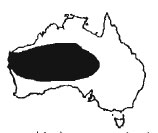Varanus Eremius
 |
Pygmy desert guanna
This husy little monitor is one of the most widespread of the pygmy goannas. It lives in desert and semi-desert areas of Western Australia. Northern Territory and South Australia but its uccurrem:e in Queensland is uncertain (Pianka 1968; Houston 1978: Storr 1980: Storr & Harold 1980). This is a ground-loving goanna that is often common in areas of spinifex, and rarer in mulga-dominated habitats. They reach a maximum size of 46cm (17cm SVL). A specimen caught in January (9.6cm SVL) weighed 11.8g. A gravid female caught in February (14.4cm SVL) weighed 38.3g (Pianka pers.comm. ).
The only populations to have been studied are those in the deserts of Western Australia. Here the pygmy desert goanna is active throughout the year, unlike most of its counterparts. They reach the peak of their activity during the late winter and early spring. During the summer they remain below ground during the warmest part of the day and are most active early in the morning. Mean body temperature of 53 active animals was 37.5°C.
This guanna spend its life on the ground and rarely climbs trees. They prey largely on other lizards (espedally skinks) but they also eat orthopterans and small numbers of scorpions, centipedes, roaches and caterpillars. They can cover large distances (almost 1km per day) exploring burrows in search of prey. They may also hide in spinifex and ambush other lizards as they pass. In the Great Victoria desert they are often found in the labyrinth-like burrows of Egernia skinks. Mating occurs in the spring and 3-4 eggs (possibly as many as 6) are laid around January and February. Preferred nest sites are unknown. The eggs probably hatch after 3-4 months. Hatchlings measure about 6.5cm SVL and sexual maturity is reached at 11-12cm SVL (Pianka 1968, 1971, 1982, 1994; Losos & Greene 1988; Thompson & Hosmer1963).
Nothing has been published about the care of this lively little goanna in captivity. A spacious enclosure (at least 1m2) with a deep sand substrate should be provided. Males might grow slightly larger than females but there are no obvious differences between the sexes. Care should be taken when housing these lizards together because they are undoubtedly cannibalistic: when given the opportunity. They feed on comparatively large prey in the wild and should be fed on a diet of big insects and vertebrates.
Attribution / Courtesy: Daniel Bennett. 1995. A Little Book of Monitor Lizards. Viper Press U.K.




